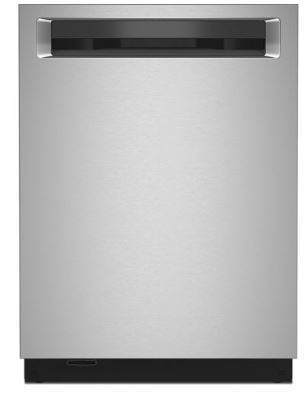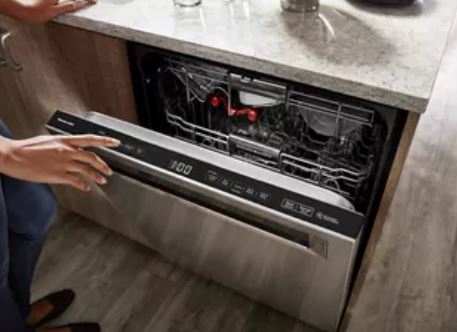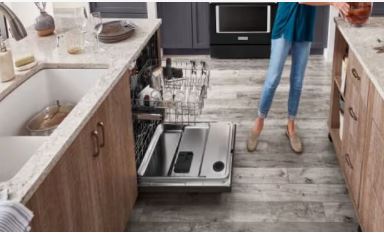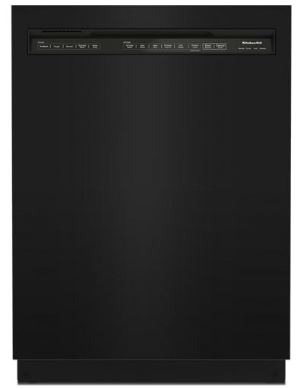For your Kitchenaid dishwasher to clean your dishes, it must get an adequate water supply. Some issues, however, could result in a Kitchenaid dishwasher not filling with water, which means you can’t do your dishes – at least not until you address the problem.
A Kitchenaid dishwasher often won’t fill up with water because of a closed water supply, low water pressure, unlatched door, poor drainage, stuck float, faulty float switch, failed water inlet valve, malfunctioning pressure switch, or defective control board.
You have to go through those nine checks if you ever want to get your Kitchenaid dishwasher back filling up with water and cleaning, and that’s where this troubleshooting guide comes into effect.
I’ll help you address the nine issues and their fixes. Furthermore, we’ll look at a few other problems related to the Kitchenaid dishwasher water-filling process so that you can also fix them. So, let’s dive in!

In a hurry? Below are quick fixes to the nine problems that stop Kitchenaid dishwashers from filling up:
Kitchenaid Dishwasher Not Filling With Water – Quick Fixes
| – | Likely Cause | Quick Fix |
| 1. | Closed Water Supply | Open the water supply valve. |
| 2. | Low Water Pressure | Unkink the inlet hose if it’s kinked, or fix/replace it if it’s leaky and replace a clogged inlet valve. |
| 3. | Unlatched Door | Latch the door firmly and resume the cycle, but replace a defective door switch. |
| 4. | Poor Drainage | Position the drain hose at least 20 inches above the subfloor or floor level and replace the drain solenoid if it’s faulty. |
| 5. | Stuck Float | Clean off any obstruction from the float and replace it if it’s damaged. |
| 6. | Faulty Float Switch | Replace the float switch if it fails the multimeter routine continuity check. |
| 7. | Failed Water Inlet Valve | Replace the water inlet valve if its supply pressure is below 20 psi. |
| 8. | Malfunctioning Pressure Switch | Replace the pressure switch if it fails the multimeter routine continuity check. |
| 9. | Defective Control Board | Replace the control board as the last recourse. |
Why Won’t My Kitchenaid Dishwasher Fill with Water?
Generally, it takes one of the nine issues below to stop your Kitchenaid dishwasher from filling up with water:
1. Closed Water Supply
Unless you turn on the water supply valve, your Kitchenaid dishwasher won’t get any water. So, check if that’s the case and rectify it.
Fix
Locate the supply valve below the sink to see if it’s open, and turn it on if it’s not. Remember to use your manual if you’ve difficulty locating the water supply valve.
2. Low Water Pressure
Ideally, the dishwasher, especially the water inlet valve, requires a water supply pressure of at least 20 psi. You can use a home water pressure gauge to check for that.
If it’s not, then your dishwasher won’t receive adequate water, and the cause of the inadequate water pressure could be any of these:
- Kinked water inlet hose
- Leaky (possibly damaged) water inlet hose
- Clogged water inlet valve
Fix
Test the water pressure using a home gauge, especially the one heading to the water inlet valve. If it’s less than 20 psi, inspect the water inlet hose for kinks, unkink it, and replace it if it’s leaky. While at it, check if the water inlet valve is clogged and replace it.
3. Unlatched Door
Your Kitchenaid dishwasher won’t fill up with water if it detects an open door. In such a case, the dishwasher will flash the Start/Resume light, and all you’ve to do is shut the door and resume its cycle.
However, sometimes the issue is a defective door switch, which won’t engage the door latch, thus preventing the door from locking securely.
Fix
Shut the door if you notice the Start/Resume light blinking, and then press Start/Resume to continue with the cycle. If that’s not the case, test the door switch with a multimeter. If it fails to display any continuity, which proves it could be faulty, replace it.

4. Poor Drainage
A Kitchenaid dishwasher must drain correctly to fill up smoothly. If there’s an issue with the drainage, the dishwasher might not fill up with water, and that often happens due to one of these issues:
- Wrong drain hose height – Ideally, the drain hose should be at least 20 inches off the subfloor or floor level so that the discharged water does not flow back. If that’s not the case, not only will the wastewater siphon back, but it’ll stop the dishwasher from filling up with clean water.
- Faulty drain solenoid – If the drain solenoid malfunctions, the drain valve will reciprocate, stopping the dishwasher from draining and filling up.
Fix
First, ensure the drain hose is at least 20 inches off the floor, and if that’s not the case, position it correctly. Then, test the drain solenoid with a multimeter. Set the multimeter on ohms, and if you get a value near infinity or far away from 40 ohms, the solenoid is defective and thus needs replacing.
5. Stuck Float or Overfill Protection
The float, or overfill protection, stops the dishwasher from overfilling. That’s its primary job. However, its malfunction could stop the dishwasher from filling up in the first place.
In most cases, the float fails from dirt obstruction, and you can tell if that’s so if the float won’t freely move when you try to jostle it around.
Fix
Try jostling the overfill protection around and clear any dirt obstruction. Replace the float, however, if it’s broken.
6. Faulty Float Switch
The float switch closes the water inlet valve when the dishwasher overfills. It malfunctions, however, and stops the dishwasher from filling up. Overall, the float switch fails due to damage or being stuck.
Fix
You can tell if the float switch is defective using the multimeter. Just check if it shows continuity and replace it if it doesn’t.
7. Failed Water Inlet Valve
The dishwasher inlet valve unseals to allow water into the dishwasher and closes when the dishwasher overfills. If it’s faulty, the dishwasher won’t fill up.
Overall, the water inlet valve fails due to sediment clogging or malfunctioning. But either way, a replacement should be on the card.
Fix
Use the home water pressure gauge to test the pressure of the water going into the water inlet valve. If the pressure is below 20 psi, replace the water inlet valve.

8. Malfunctioning Pressure Switch
The pressure switch relays the signal to the inlet valve when the correct amount of water enters the dishwasher. It, however, fails to open the inlet valve when it fails, and in such a case, the dishwasher doesn’t fill up with water.
Fix
Use a multimeter to determine if the pressure switch has continuity. Replace it if it doesn’t.
9. Defective Control Board
Lastly, your Kitchenaid dishwasher might not fill up with water because the control board is no longer effective. Mark you, the control board powers nearly all electrical parts and controls almost all functions, including water fill-up. So, if it’s faulty, the water inlet valve won’t open up, and the dishwasher won’t fill up.
Fix
Since there’s no easy way to tell a bad control board, consider its replacement your last recourse. A dishwasher expert can, however, help you check it.
Kitchenaid Dishwasher Not Getting Water to Top Rack
Water won’t get to the top rack of a Kitchenaid dishwasher for different reasons. First, it could be due to clogged spray arm nozzles, which you must unclog. Second, it could be due to an obstructed spray arm due to overloading the dishes or placing taller items on the bottom rack.
Kitchenaid Dishwasher Not Getting Any Water
Your Kitchenaid dishwasher doesn’t get any water because the water supply valve is off, the inlet hose is leaky or kinked, or the water inlet valve is dirt-clogged. And if that’s not it, the water pressure could be insufficient, the circulation pump might be faulty, or the drain hose height could be all wrong.
Kitchenaid Dishwasher Not Getting Hot Water
There are a few considerations when your Kitchenaid dishwasher won’t receive hot water. It could be that the hot water supply is off, the hot water inlet hose is leaky or kinked, or the heating element isn’t working. It could also be a thermostat or plumbing fault or wrong water temperature.
Kitchenaid Dishwasher Hums But No Water
A Kitchenaid dishwasher hums when something is amiss, and if it does without filling up with water, it’s highly likely due to a leaky or obstructed water inlet hose, blocked spray arms, or drainage fault.
But if that’s not it, it’s likely due to a defective water inlet valve, float switch, pump motor, door switch, or pressure switch.

New Kitchenaid Dishwasher Not Filling with Water
There isn’t much to check when you have a new Kitchenaid dishwasher that won’t fill up with water. In most cases, it’s an issue with the water supply. It could be that the water supply valve is off, the inlet hose is kinked, or the supplying water pressure isn’t adequate.
If that’s not it, check the dishes for overload. Some of it could be obstructing the spray arms. But still, it could be poor installation, especially the plumbing work, or just an unlatched door that you should close.
Kitchenaid Dishwasher Filling with Water But Not Washing
Your Kitchenaid dishwasher fills but does not wash due to one of these issues:
- Drain pump clogging or malfunction
- Defective pressure switch
- Temperature regulator fault
- Inadequate detergent
- Obstructed spray arms
- Bad door switch
- Broken impeller
- Faulty printed circuit board
Kitchenaid Dishwasher Filling with Water But Won’t Spray
If your Kitchenaid dishwasher fills up with water but won’t spray, it’s likely to result from obstructed spray arms (especially from dish overloading), inadequate water supply, faulty overfill switch, circulation pump fault, or a malfunctioning water inlet valve.
Concluding Thought On a Kitchenaid Dishwasher Not Filling with Water:
Generally, it takes one of the nine issues shared above to stop a Kitchenaid dishwasher from filling up with water. It could be that the water supply is off, the water pressure is insufficient, the door is open, or discharged water won’t drain properly.
But if that’s not the case, watch out for a stuck overfill protection or a defective float switch, water inlet valve, pressure switch, or control board. Only after exploring those issues should you involve an expert or Kitchenaid.
Also Read:
